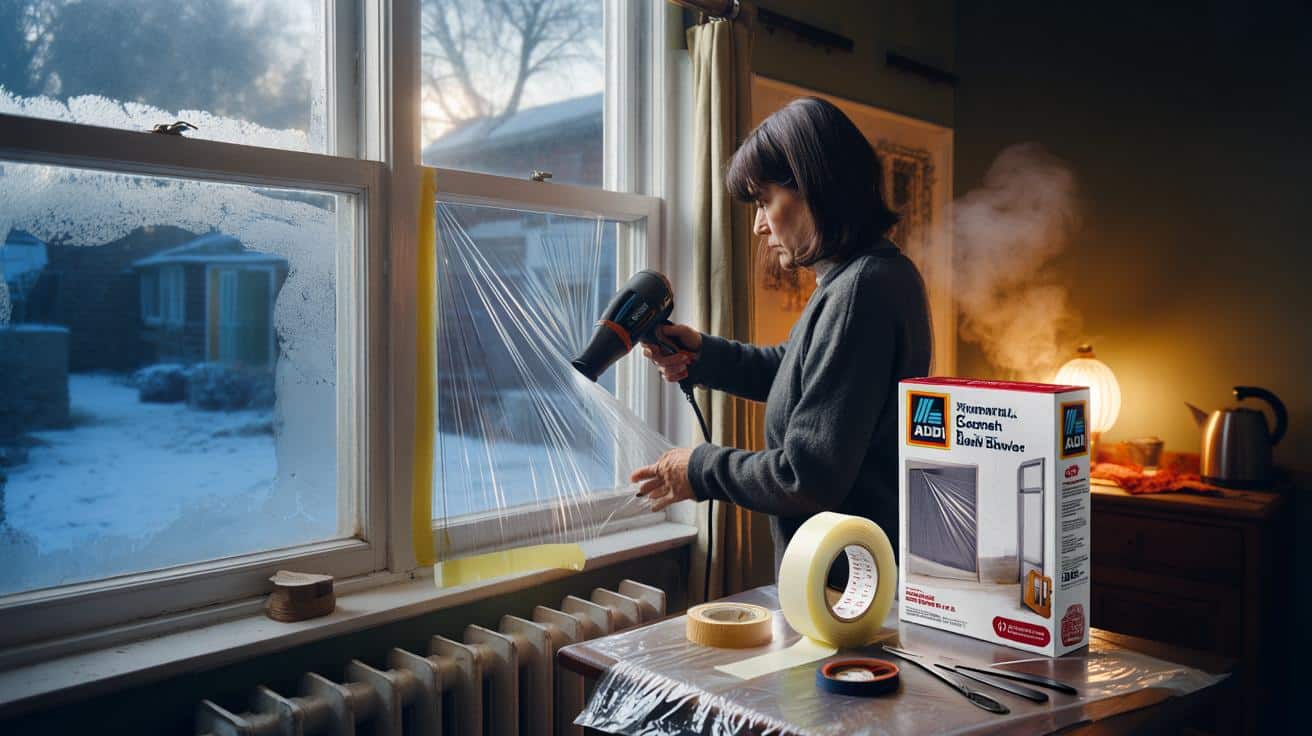The cold sneaks in under doors, whispers through window gaps, then sits in your bones. So when a £9.99 gadget pops up in Aldi, promising to slash heat loss by up to 86%, the question writes itself: is this the winter hack we were waiting for?
The morning I tested it, the kitchen window wore a faint skin of condensation and the smart meter blinked an accusatory orange. The radiator ticked away, brave but underpowered, while a ribbon of cold air curled round my ankles. Then a neighbour, hat on, coffees in hand, mentioned a “little lifesaver” waiting in the middle aisle. I walked over, still in a scarf, grabbed the last box, and ten minutes later I was heat-gunning plastic film tight as a drum. Something shifted in the room. The kettle boiled, and the draught was gone. Then the bill arrived.
Meet the £9.99 Aldi fix everyone’s hunting
At first glance, it’s delightfully unsexy: a roll of clear insulating film and a strip of draught-seal tape—the sort of kit you’d scroll past at 11pm. But peel it back and you feel the logic. The tape seals the hairline gaps around frames and sills. The film stretches across single panes or older double glazing and shrinks taut with a blast from a hairdryer, trapping a cushion of still air. Stand there after fitting and that telltale icy tickle near the glass softens. It’s small, it’s simple, and it’s oddly satisfying.
A renter in Leeds told me she did her bay window and the back door in under an hour. Her evening gas use dropped from just over 9kWh to around 7kWh on similar-weather nights, going by her smart meter. That’s not a lab test, just a life test, and her kitchen stopped feeling like a bus stop. Aldi’s own wording leans hard on that headline promise—cutting heat loss “by up to 86%”—which tends to refer to controlled conditions on single glazing and leaky gaps. Your mileage will vary, but the physics is on its side.
Here’s the why. Heat leans on two main exits by your windows and doors: conduction through the glass and convection through tiny gaps. The film creates a thin air pocket that slows conduction, while the seal tape throttles those invisible air rivers that rob rooms of warmth. Thermal images often show a duller, less “hot” window after you add the film, meaning less heat is bleeding out. Renters love it because it’s reversible. Homeowners like it because it costs less than a takeaway and plays nice with heavier fixes like thicker curtains or radiator reflector foil behind the living room rad. **£9.99 is less than a takeaway, yet it might change how your home feels at 6am.**
How to fit it right, first time
Start with a clean, dry frame. Wipe the paintwork, let it fully dry, then run the self-adhesive tape around the inside edge where the film will sit. Measure twice, cut the film with an extra centimetre or two to spare, then press it onto the tape and smooth from the centre to the corners. Now the fun bit: hit it with a hairdryer on medium, moving constantly like you’re glossing a cake. The creases pull tight, the film turns glass-clear, and the draughts fall away. Allow 20 minutes per window, tops. A warm room makes the tape stick better.
Common mistakes? Rushing the prep so the tape peels, leaving gaps at the bottom edge, and overheating one spot so the film puckers. If your frame is damp, pause and deal with the moisture first or you’ll trap trouble. Got trickle vents? Keep them clear; the goal is to stop uncontrolled draughts, not to starve the room of fresh air. We’ve all had that moment when the cold makes you eat dinner in your coat. Let’s be honest: nobody actually does that every day. This is about balance, not perfection. **Small seals, big savings—draught-proofing adds up faster than you think.**
Here’s what it feels like in practice. My fingers actually thawed while I made tea. A Mancunian I spoke to swears by the combo: film the windows, snake the door, foil the radiator on an external wall.
“I did the front room on a rainy Sunday,” Sarah told me. “Hairdryer, a podcast, and a cup of tea. The room warmed faster, and the thermostat stopped yo-yoing. It’s not magic. It’s just less waste.”
- Layer it: clear film on draughty panes, heavy curtains after dark.
- Stick radiator reflector foil behind rads on external walls.
- Use a door snake or brush strip on the biggest gap in the house.
- Pop a brush on the letterbox; a tiny gale lives there.
- Consider a chimney balloon in disused fireplaces.
What the 86% promise means for your winter
That “up to 86%” line is a ceiling, not a guarantee. Think of it as the top end of what’s possible when film meets cold glass on a leaky frame under lab-like conditions. In the real world, the win is more modest but still tasty: calmer rooms, fewer cold spots, a chattier thermostat that rests instead of sprinting. Stack small moves and the room starts to hold heat like a decent thermos. **If you rent, removable film is your secret weapon this winter.**
There’s a wider story here. The UK’s homes are a patchwork of eras, from Victorian sashes to 90s uPVC, stitched together by whatever the last owner fancied. Draught-proofing is the rare fix that cuts through all that without a permission slip or a payment plan. It pairs nicely with a one-degree nudge on the thermostat, a smart plug on the heater you always forget, or a cheap door brush your kids can install. It’s the kind of low-stress, low-cost habit that turns colder months from a slog into something you can manage.
Aldi’s aisles won’t solve energy insecurity. They will, though, hand you something that pays for itself in a few chilly evenings. If you try it, share what happens. Tell the truth about where your home leaks, where it sighs with relief, and what still needs work. Neighbours borrow courage. And winter feels a little less like a challenge you face alone.
| Point clé | Détail | Intérêt pour le lecteur |
|---|---|---|
| What the £9.99 gadget is | Clear window insulation film plus draught-seal tape from Aldi’s middle aisle | Know exactly what to look for and how it works |
| “Up to 86%” explained | Top-end reduction in heat loss under controlled conditions on leaky single glazing | Set realistic expectations for your home |
| Fast, renter-friendly install | Clean, stick, stretch with a hairdryer; removes without damage after winter | Practical, low-risk way to cut bills this season |
FAQ :
- What exactly does Aldi’s £9.99 kit include?Typically a roll of transparent insulating film and a length of self-adhesive draught-seal tape, plus simple instructions.
- Does it really cut heat loss by up to 86%?That figure comes from controlled tests on specific setups. You may feel a big improvement, but real homes vary, so treat it as a best-case metric.
- Is it safe for renters and painted frames?Yes, it’s designed to be removable. Warm the tape with a hairdryer when taking it off to minimise residue on paint or uPVC.
- Will it help with condensation?Often, yes. The inner surface sits warmer, so less moisture condenses. Deal with existing damp first and keep trickle vents open to maintain airflow.
- Can I use it on double glazing or just single panes?It works on both, but the biggest gains tend to be on older, leakier windows and doors where draughts are worst.









That “up to 86%” reeks of best-case lab talk. In a draughty Victorian flat with single glazing and leaky sashes, sure—but has anyone got before/after kWh from a smart meter over a week? Anecdotes are nice; numbers are nicer. Also, how long before the tape starts to peel when frames get damp?
Grabbed the kit in the middle aisle today—last box! Hairdryer, podcast, job done in 25 mins per window. Kitchen stopped feeling like a bus stop and the kettle steam no longer turns the pane into a waterfall. My smart meter dipped from ~8.5kWh to 7.1kWh tonight. Could be weather, but feels legit.